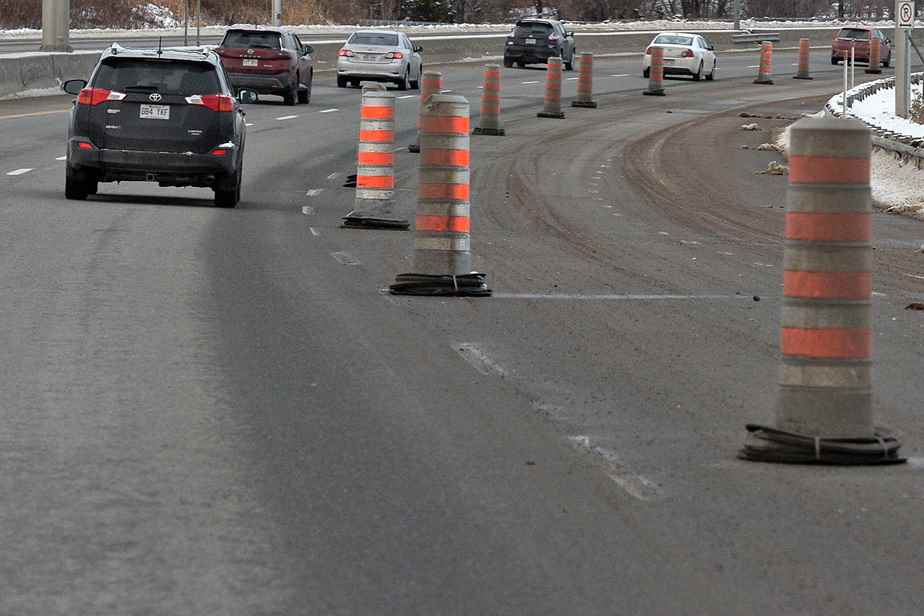(Quebec) Quebec City has the reputation of being a “city of tanks”, one of the municipalities with the most kilometers of highways per inhabitant in the country. A little too much for the taste of the city hall, which formally asks the government to reduce two highways near its city center.
The mayor of Quebec sent a letter dated January 25 to two government ministers, Geneviève Guilbault and Jonatan Julien, formally asking them “to begin the steps that will lead to the conversion of the Dufferin-Montmorency highway into an urban boulevard “.
This expressway built in the early 1970s in the middle of working-class neighborhoods connects Parliament Hill to the eastern suburbs. The City is concerned about its dangerousness. An accident killed four people on this highway in 2021, in the borough of Beauport. Another frontal accident on Monday revived the debate.
“It’s a safety issue, but also an air pollution issue. When the report [sur la qualité de l’air à Limoilou] came out last week, an early issue [était le] road transport”, explained this week the mayor of Quebec, Bruno Marchand.
The formal request from the City of Quebec for Dufferin-Montmorency – between Henri-Bourassa and the Île d’Orléans bridge – is in addition to another request for the transformation of part of the Laurentian highway into an urban boulevard . This northbound highway ends in the heart of the Saint-Roch district.
According to data from the Transportation Association of Canada dating from 2010, Quebec has 1.09 km of highway per 1,000 inhabitants. It is second in the country in this regard, behind Calgary (1.2), but ahead of Montreal (0.83).
The City plans to develop the perimeters of these two sections of highway, which currently resemble trenches at the gates of the city centre. ” Discussions are ongoing. Our demands are clear. We made them to the ministers concerned, repeatedly,” said Mr. Marchand.
The transformation of these sections of highway into urban boulevards arouses a consensus at the municipal council.
“I salute the gesture of the mayor to send an official communication to the government of Quebec,” said independent councilor Jean-François Gosselin this week. The former leader of the opposition had launched his career in municipal politics by attacking Régis Labeaume’s “war on the car” and defending a third link.
“I’m happy with the unanimity we have. It goes beyond the parties,” noted the leader of the official opposition, Claude Villeneuve.
The MTQ will have the last word
But the unanimity of the elected officials of Quebec will not weigh heavily if the Ministry of Transport of Quebec (MTQ), which is responsible for these highways, opposes an end of inadmissibility.
In May 2022, a dozen mayors had published an open letter in The Press deploring the lack of attention from the MTQ to their demands for the securing of the roads for which it is responsible.
“The Ministère des Transports should be an essential partner in achieving this objective,” wrote the mayors, in particular those of Joliette and Marieville. “We are seeing the opposite: major obstacles are slowing down actions aimed at securing the roads under the management of the MTQ that cross our municipalities. »
For the moment, the Minister of Transport, Geneviève Guilbault, does not comment frankly on the transformation into an urban boulevard of Dufferin-Montmorency. She insists instead on the modifications made to the accident-prone intersection, such as the installation of a photo radar on February 3.
I want to reassure everyone: the data shows that this segment is safe. That said, we continue to analyze the various parameters. Like everywhere else, our priority is safety.
The Minister of Transport, Geneviève Guilbault, through her cabinet
This is not the first time that Quebec has asked for fewer highways, underlines Alexandre Turgeon, director general of the Regional Council for the Environment of the Capitale-Nationale.
He recalls that Mayor Jean-Paul L’Allier was already calling for the transformation of the Laurentian highway into an urban boulevard. The mayoress of Sainte-Foy Andrée Boucher asked the same thing for the Duplessis highway, he said.

“But they weren’t demands with so much pressure. And those were the 1990s, we were in the race for a zero deficit, there was no money. It was requested, but there was a kind of fatalism. There, it’s different, ”believes Mr. Turgeon.
The ecologist has no illusions: the transformation of these two sections of motorway is far from certain. But he thinks it’s not impossible. “Geneviève Guilbault has shown in several files that she knows how to listen and understand the issues,” he says.
Another question hovers in this file: the third link project dear to the CAQ must exit in Quebec near the Laurentian highway, where the City is calling for an urban boulevard.
